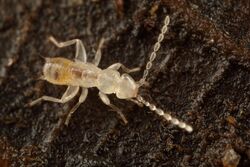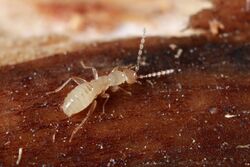Biology:Zoraptera
| Zoraptera | |
|---|---|

| |
| Zorotypus from Los Bancos, Pichincha, Ecuador | |
| Scientific classification | |
| Domain: | Eukaryota |
| Kingdom: | Animalia |
| Phylum: | Arthropoda |
| Class: | Insecta |
| Subclass: | Pterygota |
| Infraclass: | Neoptera |
| Cohort: | Polyneoptera |
| Order: | Zoraptera Silvestri, 1913 |
| Families | |
| |
| Diversity | |
| 51 species | |
The insect order Zoraptera, commonly known as angel insects, contains small and soft bodied insects with two forms: winged with wings sheddable as in termites, dark and with eyes (compound) and ocelli (simple); or wingless, pale and without eyes or ocelli. They have a characteristic nine-segmented beaded (moniliform) antenna. They have mouthparts adapted for chewing and are mostly found under bark, in dry wood or in leaf litter.[1]

Description
The name Zoraptera, given by Filippo Silvestri in 1913,[2] is misnamed and potentially misleading: "zor" is Greek for pure and "aptera" means wingless. "Pure wingless" clearly does not fit the winged alate forms, which were discovered several years after the wingless forms had been described.
The members of this order are small insects, 3 millimetres (0.12 in) or less in length, that resemble termites in appearance and in their gregarious behavior. They are short and swollen in appearance. They belong to the hemimetabolous insects. They possess mandibulated biting mouthparts, short cerci (usually 1 segment only), and short antennae with 9 segments. The abdomen is segmented in 11 sections.[3] The maxillary palps have five segments, labial palps three, in both the most distal segment is enlarged. They have six Malpighian tubules, and their abdominal ganglia have fused into two separate ganglionic complexes.[4] Immature nymphs resemble small adults. Each species shows polymorphism. Most individuals are the apterous form or "morph", with no wings, no eyes, and no or little pigmentation. A few females and even fewer males are in the alate form with relatively large membranous wings that can be shed at a basal fracture line. Alates also have compound eyes and ocelli, and more pigmentation. This polymorphism can be observed already as two forms of nymphs. Wingspan can be up to 7 millimetres (0.28 in), and the wings can be shed spontaneously. When observed, wings have simple venation.[3] Under good conditions the blind and wingless form predominates, but if their surroundings become too tough, they produce offspring which develop into winged adults with eyes. The wings are paddle shaped, and have reduced venation.
Systematics
Phylogeny
The phylogenetic relationship of the order remains controversial and elusive. At present the best supported position based on morphological traits recognizes the Zoraptera as polyneopterous insects related to the webspinners of the order Embioptera. However, molecular analysis of 18s ribosomal DNA supports a close relationship with the superorder Dictyoptera.[5][6][7][8][9]
The following cladogram, based on the molecular phylogeny of Wipfler et al. 2019, places Zoraptera as the sister group of Dermaptera (earwigs); Zoraptera and Dermaptera together form the sister group of the remaining Polyneoptera:[10]
| Polyneoptera |
| ||||||||||||||||||||||||||||||||||||||||||||||||||||||
Classification
The Zoraptera are currently divided into two families, four subfamilies, nine genera and a total of 51 species, some of which have not been yet described.[11][12][13] There are eleven extinct species known as of 2017, many of the fossil species are known from Burmese amber.[14]
- Family Zorotypidae Silvestri, 1913, stat. revid. Kočárek, Horká & Kundrata, 2020
- Subfamily Zorotypinae Silvestri, 1913
- Subfamily Spermozorinae Kočárek, Horká & Kundrata, 2020
- Spermozoros Kočárel, Horká & Kundrata, 2020 — 6 spp.
- Family Spiralizoridae Kočárek, Horká & Kundrata, 2020
- Subfamily Latinozorinae Kočárek, Horká & Kundrata, 2020
- Latinozoros Kukalova-Peck & Peck, 1993, stat. restit. Kočárek, Horká & Kundrata, 2020 — 3 spp.
- Subfamily Spiralizorinae Kočárek, Horká & Kundrata, 2020
- Spiralizoros Kočárek, Horká & Kundrata, 2020 — 12 spp.
- Centrozoros Kukalova-Peck & Peck, 1993 stat. restit. Kočárek, Horká & Kundrata, 2020 (=Meridozoros Kukalova-Peck & Peck, 1993; Floridazoros Kukalova-Peck & Peck, 1993) — 8 spp.
- Cordezoros Kočárek, Horká & Kundrata, 2020 — 1 sp.
- Scapulizoros Kočárek, Horká & Kundrata, 2020 — 1 sp.
- Brazilozoros Kukalova-Peck & Peck, 1993 stat. restit. Kočárek, Horká & Kundrata, 2020 — 3 spp.
- Subfamily Latinozorinae Kočárek, Horká & Kundrata, 2020
Incertae sedis
The following nine species are considered Zoraptera incertae sedis:[11]
- Zorotypus congensis van Ryn Tournel, 1971
- Zorotypus javanicus Silvestri, 1913
- Zorotypus juninensis Engel, 2000
- Zorotypus leleupi Weidner, 1976
- Zorotypus longicercatus Caudell, 1927
- Zorotypus newi (Chao & Chen, 2000) Engel & Grimaldi, 2000 (=Formosozoros newi Chao & Chen, 2000)
- Zorotypus sechellensis Zompro, 2005
- Zorotypus swezeyi Caudell, 1922
Extinct taxa
- †Xenozorotypus Engel & Grimaldi 2002
- †Xenozorotypus burmiticus Engel & Grimaldi 2002 - Burmese amber, Myanmar (Cretaceous)
Behavior and ecology
Zorapterans live in small colonies beneath rotting wood, lacking in mouthparts able to tunnel into wood, but feeding on fungal spores and detritus. These insects can also hunt smaller arthropods like mites and collembolans.[15]
Centrozoros gurneyi lives in colonies which range in size from a few dozen to several hundred individuals, but most often number about 30 individuals. The males are slightly larger than the females, and they fight for dominance.[16]
When two colonies of Usazoros hubbardi are brought together experimentally, there is no difference in behavior towards members of the new colony. Therefore, colonies in the wild might merge easily. Winged forms are rare. The males in most colonies establish a linear dominance hierarchy in which age or duration of colony membership is the prime factor determining dominance. Males appearing later in colonies are at the bottom of the hierarchy, regardless of their body size. By continually attacking other males, the dominant male monopolizes a harem of females. The members of this harem stay clumped together. There is a high correlation between rank and reproductive success of the males.[17][18]
Latinozoros barberi lack such a dominance structure but display complex courtship behavior including nuptial feeding. The males possess a cephalic gland that opens in the middle of their head. During courtship they secrete a fluid from this gland and offer it to the female. Acceptance of this droplet by the female acts as behavioral releaser and immediately leads to copulation.[15]
In Spermozoros impolitus, copulation does not occur, but fertilization is accomplished instead by transfer of a spermatophore from the male to the female. This 0.1-millimetre (0.0039 in) spermatophore contains a single giant sperm cell, which unravels to about the same length as the female herself, 3 millimetres (0.12 in). It is thought that this large sperm cell prevents fertilization by other males, by physically blocking the female's genital tract.[19][20]
Effects on ecosystem
Zoraptera are thought to provide some important services to ecosystems. By consuming detritus, such as dead arthropods, they assist in decomposition and nutrient cycling.[21]
References
- ↑ Rafael, JA; Godoi, FDP; Engel, MS (2008). "A new species of Zorotypus from eastern Amazonia, Brazil (Zoraptera: Zorotypidae)". Transactions of the Kansas Academy of Science 111 (3 & 4): 193–202. doi:10.1660/0022-8443-111.3.193.
- ↑ Silvestri, F. (1913). "Descrizione di un nuovo ordine di insetti". Bollettino del Laboratorio di Zoologia Generale e Agraria della R. Scuola Superiore d'Agricoltura in Portici 7: 193–209. https://archive.org/stream/bollettinodellab71913rscufo#page/193/mode/1up.
- ↑ 3.0 3.1 Gullan; Granston (2005). The Insects: An Outline of Entomology.
- ↑ Evolution of attachment structures in the highly diverse Acercaria (Hexapoda)
- ↑ Yoshizawa (2007). "The Zoraptera problem: evidence for Zoraptera + Embiodea from the wing base". Systematic Entomology 32 (2): 197–204. doi:10.1111/j.1365-3113.2007.00379.x. https://eprints.lib.hokudai.ac.jp/dspace/bitstream/2115/33766/1/SE32-2.pdf.
- ↑ Yoshizawa, K; Johnson, KP (2005). "Aligned 18S for Zoraptera (Insecta): Phylogenetic position and molecular evolution". Molecular Phylogenetics and Evolution 37 (2): 572–580. doi:10.1016/j.ympev.2005.05.008. PMID 16005647.
- ↑ Engel, MS; Grimaldi, DA (2002). "The first mesozoic Zoraptera (Insecta)". American Museum Novitates (3362): 1–20. doi:10.1206/0003-0082(2002)362<0001:tfmzi>2.0.co;2.
- ↑ Ishiwata, K; Sasaki, G; Ogawa, J; Miyata, T; Su, Z-H (2011). "Phylogenetic relationships among insect orders based on three nuclear protein-coding gene sequences". Molecular Phylogenetics and Evolution 58 (2): 169–180. doi:10.1016/j.ympev.2010.11.001. PMID 21075208.
- ↑ Wang, X.; Engel, M.S.; Rafael, J.A.; Dang, K.; Wu, H.; Wang, Y.; Xie, Q.; Bu, W. (2013). "A unique box in 28S rRNA is shared by the enigmatic insect order Zoraptera and Dictyoptera". PLOS ONE 8 (1): e53679. doi:10.1371/journal.pone.0053679. PMID 23301099. Bibcode: 2013PLoSO...853679W.
- ↑ Wipfler, Benjamin; Letsch, Harald; Frandsen, Paul B.; Kapli, Paschalia; Mayer, Christoph; Bartel, Daniela; Buckley, Thomas R.; Donath, Alexander et al. (February 2019). "Evolutionary history of Polyneoptera and its implications for our understanding of early winged insects". Proceedings of the National Academy of Sciences 116 (8): 3024–3029. doi:10.1073/pnas.1817794116. PMID 30642969. Bibcode: 2019PNAS..116.3024W.
- ↑ 11.0 11.1 Kočárek, Petr; Horká, Ivona; Kundrata, Robin (12 January 2020). "Molecular Phylogeny and Infraordinal Classification of Zoraptera (Insecta)". Insects 11 (51): 51. doi:10.3390/insects11010051. PMID 31940956.
- ↑ Zoraptera Species File (Version 5.0/5.0; retrieved 29 May 2021)
- ↑ "Order Zoraptera Silvestri 1913". The Paleobiology Database. https://paleobiodb.org/classic/checkTaxonInfo?taxon_no=183857&is_real_user=1.
- ↑ Yin, Ziwei; Cai, Chenyang; Huang, Diying (2018). "New zorapterans (Zoraptera) from Burmese amber suggest higher paleodiversity of the order in tropical forests". Cretaceous Research 84: 168–172. doi:10.1016/j.cretres.2017.11.028.
- ↑ 15.0 15.1 Choe, Jae C. (1997). "The evolution of mating systems in the Zoraptera: mating variations and sexual conflicts". in Choe, Jae C.. The Evolution of Mating Systems in Insects and Arachnids. Cambridge: Cambridge University Press. pp. 130–145. doi:10.1017/cbo9780511721946.008. ISBN 978-0-511-72194-6.
- ↑ The Other Insect Societies
- ↑ Choe, Jae C. (1994). "Sexual selection and mating system in Zorotypus gurneyi Choe (Insecta: Zoraptera)". Behavioral Ecology and Sociobiology, II. Determinants and Dynamics of Dominance 34 (4): 233–237. doi:10.1007/bf00183473. ISSN 0340-5443. https://deepblue.lib.umich.edu/bitstream/2027.42/46901/1/265_2004_Article_BF00183473.pdf.
- ↑ Choel, Jae C. (1994). "Sexual selection and mating system in Zorotypus gurneyi Choe (Insecta : Zoraptera), I. Dominance hierarchy and mating success". Behavioral Ecology and Sociobiology 34 (2): 87–93. doi:10.1007/bf00164179. ISSN 0340-5443.
- ↑ Dallai, R. et al. (12 May 2013). "Divergent mating patterns and a unique mode of external sperm transfer in Zoraptera: an enigmatic group of pterygote insects". Naturwissenschaften 100 (6): 581–594. doi:10.1007/s00114-013-1055-0. ISSN 0028-1042. PMID 23666111. Bibcode: 2013NW....100..581D.
- ↑ "The tiny insect with the massive sperm". New Scientist (2919): 17. 1 June 2013. https://www.newscientist.com/article/mg21829195.600-the-tiny-insect-with-the-massive-sperm.html#.Uk_8o1CTg_Y.
- ↑ Engel, Michael (2007). "The Zorotypidae of Fiji (Zoraptera)". Bishop Museum Occasional Papers. http://hbs.bishopmuseum.org/pubs-online/pdf/op91.pdf#page=35.
General references
- Costa JT 2006 Psocopera and Zoraptera. In: Costa JT The other Insect Societies. The Belknap Press of Harvard University Press, Cambridge, MA and London, UK pp 193–211
- Grimaldi, David; Engel, Michael S. (16 May 2005). Evolution of the Insects. Cambridge University Press. ISBN 978-1-107-26877-7. OCLC 56057971. https://books.google.com/books?id=odQmAAAAQBAJ&pg=PR4.
- Hubbard, Michael D. (1990). "A Catalog of the Order Zoraptera (Insecta)". Insecta Mundi 4 (1–4). http://digitalcommons.unl.edu/insectamundi/393/.
- Rafael, José Albertino; Engel, Michael S. (2006). "A new species of Zorotypus from central Amazonia, Brazil (Zoraptera: Zorotypidae)". American Museum Novitates (3528): 1–11. doi:10.1206/0003-0082(2006)3528[1:ANSOZF2.0.CO;2]. http://digitallibrary.amnh.org/handle/2246/5806.
- Kaddumi, Hani F. (2005). "Amber of Jordan, the Oldest Prehistoric Insects in Fossilized Resin.". Publications of the Eternal River (Amman.: Museum of Natural History): 168. OCLC 235969870. https://www.academia.edu/19770324.
External links
- Tree of Life Zoraptera
- "Zorotypidae Silvestri, 1913". http://zoraptera.speciesfile.org/Common/basic/Taxa.aspx?TaxonNameID=1218730.
Wikidata ☰ Q540502 entry
 |



